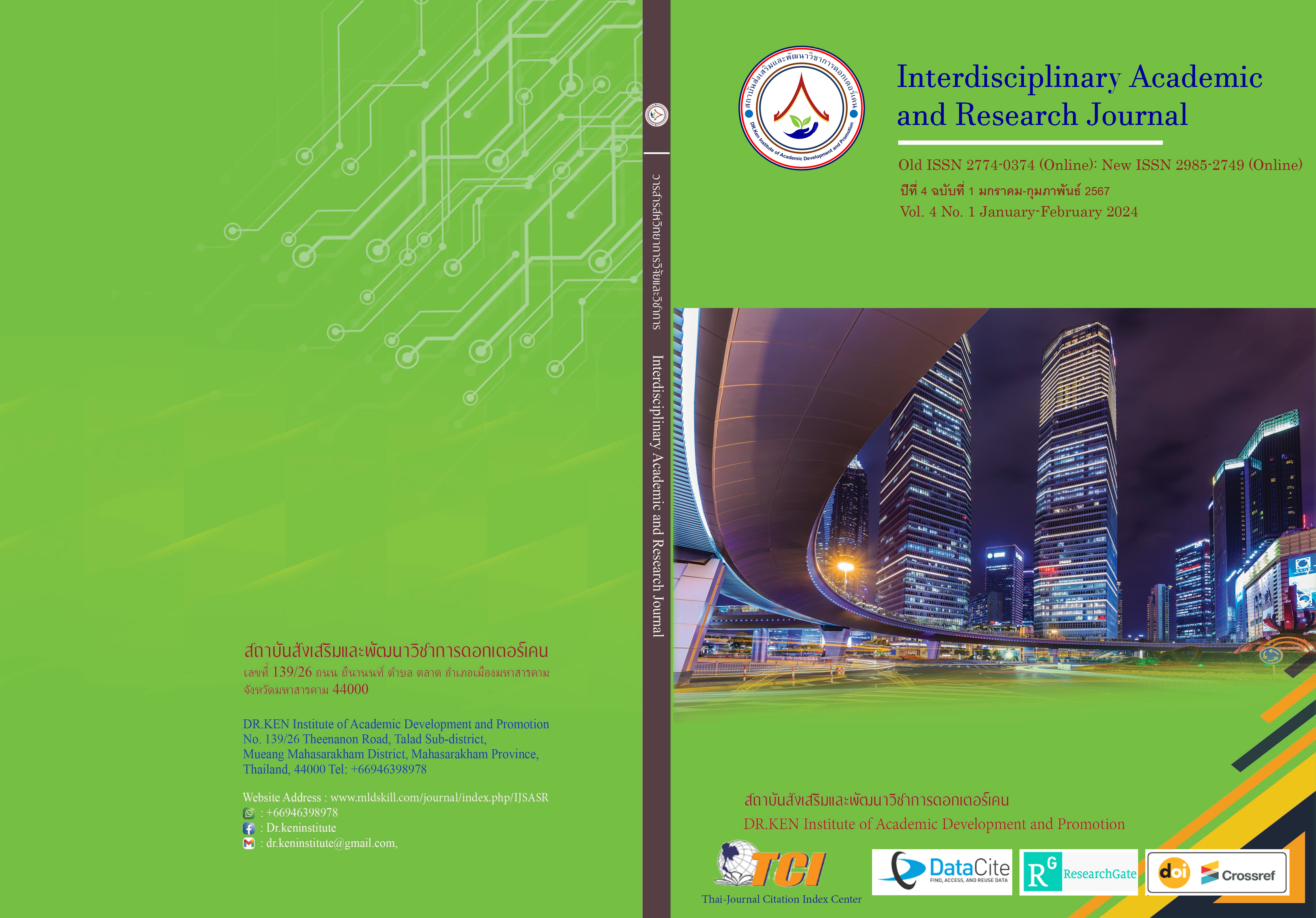Development of Training to Enhance the Ability to Assist Individuals with Physical or Mobility Disabilities or Health for the Staff and Parents at a Special Education Center
DOI:
https://doi.org/10.60027/iarj.2024.272468Keywords:
Training Courses; , Physical or Mobility Disabilities or Health; , Special Education CenterAbstract
Background and Aims: Office of Special Education Administration regarding the development of efficiency in educational administration for people with disabilities and the disadvantaged, enhancing efficiency in providing educational services, and training for disabled and underprivileged people to continue their education at a higher level. The objectives of this research were 1) to study basic information, current conditions, and training needs, 2) to develop the training curriculum, 3) to Implement the training curriculum, and 4) to evaluate the training curriculum and proceed with it by using the research and development procedure.
Methodology: The research is divided into 4 phases. The sample group is 222 staff and parents at the Special Educational Center and is assigned. The target group is the information providers used in the seven expert seminars. The samples used in the trial course were 30 employees and parents. staff and parents at the center. Lastly, phase 4 is to evaluate the training curriculum. The tools are questionnaires, interviews, an assessment of conformity, a suitability, test, and a satisfaction questionnaire. Statistics in data analysis were percentage, mean, standard deviation, and One-Samples T-test.
Result: (1) The overall level of the current state of training to develop training to enhance the ability to assist individuals with physical and mobility disabilities or health for the staff and parents at the Special Educational Center was moderate. In addition, the overall need for training is at the highest level. (2) According to the result of developing a training curriculum, it is found that the training curriculum consisted of 6 components: 1) Principles of the curriculum 2) Objectives of the curriculum 3) Contents of the curriculum 4) Training activities 5) Media and learning resources, and 6) measurement and evaluation. The overall outcome of the curriculum quality assurance was the highest level of consistency Considering individually, the quality assurance and appropriateness are also at the highest levels. In addition, it is most suitable in all aspects. (3) According to the result of the training to develop a training curriculum, it shows that the post-test average score of the participants is 55.10 out of 60 representing 91.83 percent. With the criteria of 80 percent, it is found that the average score after training is significantly higher than the criteria of 80 percent at the .01 level. Additionally, the overall satisfactory score of the participants is at the highest level. Considering individually, the participants are satisfied with the training at the highest level in all aspects as well. (4) According to the evaluation results of the training Curriculum it presents that the experts’ opinions are overall at a high level in all aspects. Sorted in descending order, it is the context evaluation, the input, the process, the result, and the product evaluation.
Conclusion: Research indicates that the curriculum provides the highest level of support for people with physical or mobility disabilities and is consistent and appropriate in all aspects of the curriculum. Trainees' abilities improved significantly and expert reviews were highly rated in both post-training course evaluations.
References
ทิศนา แขมมณี, (2545). รูปแบบการเรียนการสอน: ทางเลือกที่หลากหลาย. กรุงเทพฯ : สำนักพิมพ์แห่งจุฬาลงกรณ์มหาวิทยาลัย.
ธำรง บัวศรี. (2552). ทฤษฎีหลักสูตร: การออกแบบหลักสูตรและการพัฒนา. กรุงเทพฯ: ธนรัช.
นิรมล ศตวุฒิ. (2543). การพัฒนาหลักสูตร. พิมพ์ครั้งที่ 2. กรุงเทพฯ: สำนักพิมพ์ มหาวิทยาลัยรามคำแหง.
บุญชม ศรีสะอาด. (2553). การวิจัยเบื้องต้น. พิมพ์ครั้งที่ 7. กรุงเทพฯ: สุวิริยาสาส์น.
พัฒนา สุขประเสริฐ. (2543). กลยุทธในการฝึกอบรม. พิมพ์ครั้งที่ 3. กรุงเทพฯ: มหาวิทยาลัยเกษตรศาสตร์.
สงัด อุทรานันท์. (2532). พื้นฐานและหลักการพัฒนาหลักสูตร. กรุงเทพฯ: วงเดือนการพิมพ์.
สงัด อุทรานันท์. (2545). การนิเทศการสอน : หลักการ ทฤษฎีและปฏิบัติ.กรุงเทพฯ: โรงพิมพ์มิตรสยาม.
สำนักบริหารงานการศึกษาพิเศษ. (2553). สารสนเทศสำนักบริหารงานการศึกษาพิเศษ. Retrieved on November 15, 2022, from: http://special.obec.go.th
สิทธิพล อาจอินทร์. (2563). การพัฒนาหลักสูตร. พิมพ์ครั้งที่ 5. ขอนแก่น: โรงพิมพ์มหาวิทยาลัยขอนแก่น.
สุมิตร คุณากร, (2550). หลักสูตรและการสอน. พิมพ์ครั้งที่ 4. กรุงเทพฯ : โรงพิมพ์ชวนพิมพ์.
สุวิมล ว่องวานิช, (2548). กลยุทธ์ทางเลือกเพื่อพัฒนาวัฒนธรรมและสมรรถภาพการวิจัย และประเมินของครูมืออาชีพในฐานะผู้นำการเปลี่ยนแปลง ในการขับเคลื่อนสู่โรงเรียนฐานความรู้ : การวิจัยประเมินความต้องการจำเป็นแบบสมบูรณ์. คณะครุศาสตร์ จุฬาลงกรณ์มหาวิทยาลัย.
Oliva, P.F. (1992). Developing the Curriculum. 3rd edition. New York: Harper Collins.
Saylor, J.G., & Alexander, W.M. (1974). Planning Curriculum for School. New York: Holt, Rinehart, and Winston.
Saylor, J.G., Alexander, W.M., & Lewis, A.J. (1981). Curriculum planning for better teaching and learning. New York: Holt, Rinehart and Winston
Taba, H. (1962). Curriculum development: Theory and practice. New York: Harcourt, Brace & World.
Tyler, R. W. (1949). Basic principles of curriculum and instruction. Chicago: University of Chicago Press.
Downloads
Published
How to Cite
Issue
Section
License
Copyright (c) 2024 Jassada Veangpol, Nattachai Jantachum, Tipaporn Sujaree

This work is licensed under a Creative Commons Attribution-NonCommercial-NoDerivatives 4.0 International License.
Copyright on any article in the Interdisciplinary Academic and Research Journal is retained by the author(s) under the under the Creative Commons Attribution-NonCommercial-NoDerivatives 4.0 International License. Permission to use text, content, images, etc. of publication. Any user to read, download, copy, distribute, print, search, or link to the full texts of articles, crawl them for indexing, pass them as data to software, or use them for any other lawful purpose. But do not use it for commercial use or with the intent to benefit any business.
















.png)


